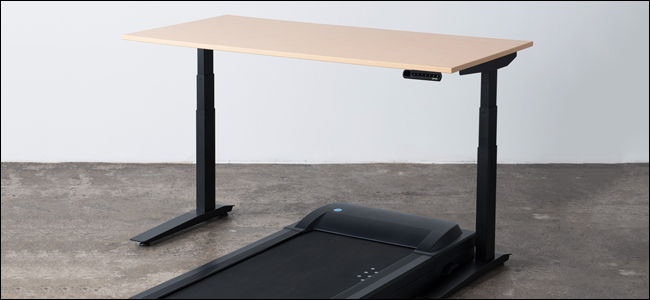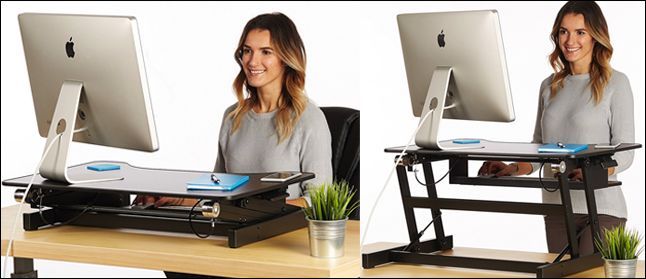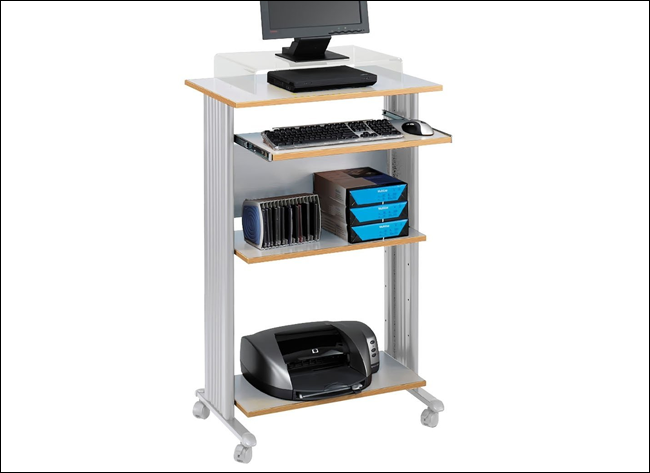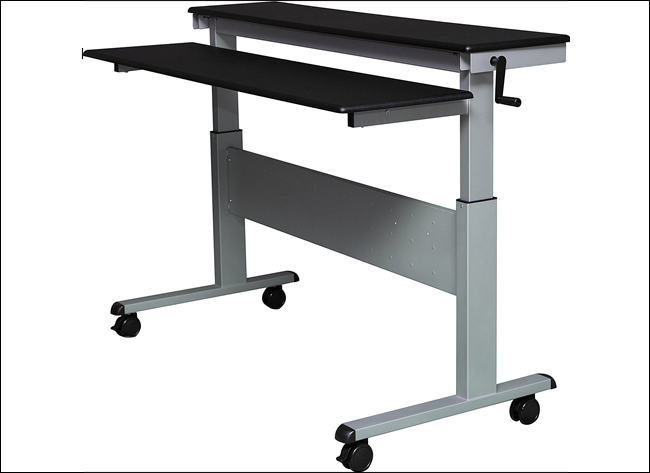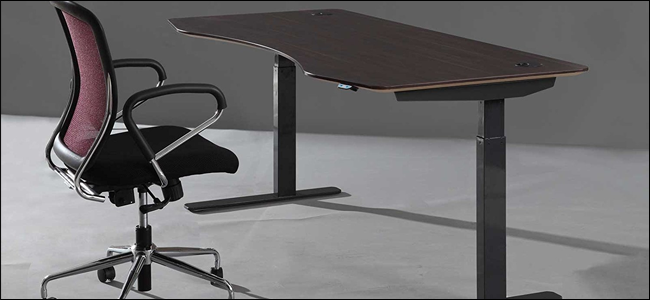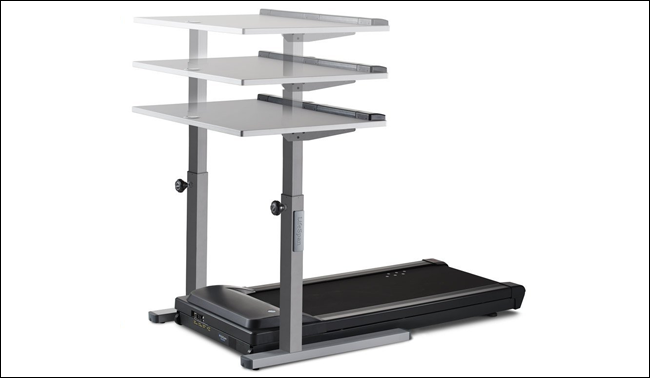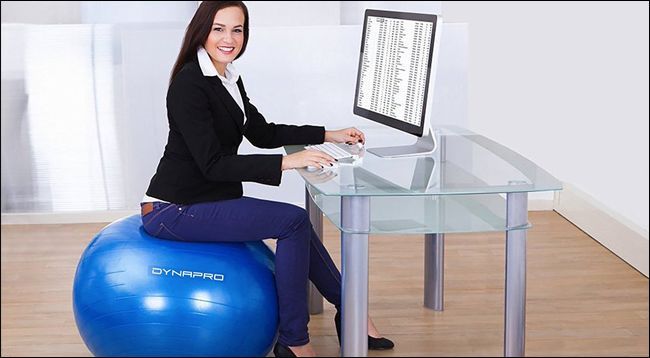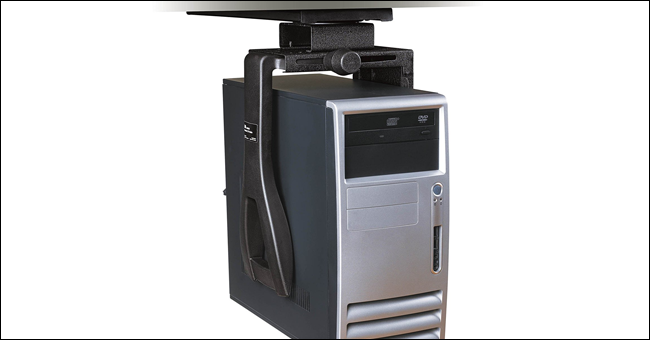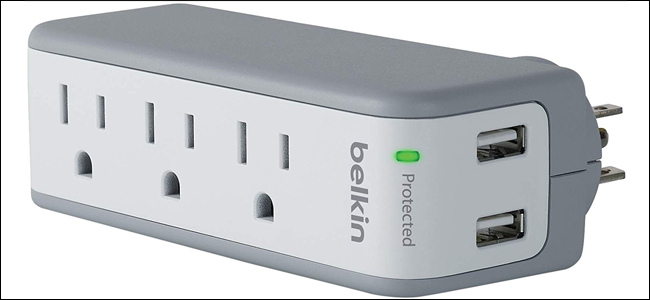Quick Links
The verdict is still out on whether standing desks, as a verified thing, are actually better for you in the long run. As someone with some pretty severe back problems myself, I swear by them, and I've done a lot of research into the best options, both ergonomically and in terms of budget. Let's have a look, shall we?
Sit-To-Stand Adapters
These gadgets are basically mini-desks that sit on the surface of your conventional seated desk, and rise up when you want to stand. They range from extremely simple, with wooden or metal risers and grooves that you need to operate manually, to lever or gas-operated lifting mechanisms, like the one in your office chair. Most of them include a separate keyboard tray, to keep an ideally ergonomic space between the computer screen and the typing surface. Popular models include the Varidesk in various sizes and features ($175-400) and the Vivo adjustable converter ($197-210).
Adapters are a good place to start if you'd like to try out the standing desk craze without investing a lot of money into a totally new setup. They're relatively inexpensive, they'll work on almost any standard desk, and they're easy to move from place to place (especially if you use a laptop). On the other hand, they have a small surface area and weight limits, so more complex multi-monitor setups aren't compatible.
Fixed Standing Desks
Unlike more elaborate solutions, a fixed standing desk sits at a single height for standing adults, and does not lower to a seated height. While these fixed desks may have a small amount of adjustability for the sake of varying user heights and ergonomics (usually with some kind of locking bolt system), they're too tall even at the lowest setting to be effectively used while sitting. Safco ($180) and Buddy ($187 and higher) are popular vendors with inexpensive options.
Fixed desks are often combined with exercise equipment like treadmills or stationary bikes, creating a dedicated work/exercise station usually meant for short bursts with a laptop. They can be cheaper than sit-to-stand desks, but they generally require either a secondary computer or a laptop to use effectively, not to mention a second work area for sitting.
Hand-Cranked Sit-To-Stand Desks
A sit-to-stand desk is ideal for someone who wants a single work area that can accommodate both sitting and standing. The cheapest option is a hand-cranked model, which uses a rotary crank to raise and lower the surface of the desk while the feet stay in place. It's the same sort of mechanism as a rotary jack on a big cargo trailer. Forgiving gearing and locking systems keep users from tiring out and the desk from "falling" on its riser system.
The Stand-Up Desk Store has well-reviewed crank models starting at just $200, and full-sized options are surprisingly economical if you can supply your own desktop surface. (If you have a current office desk you want to convert, it's easy to screw an adjustable standing frame onto a desktop from a flat-pack assembled desk.) Without the specialized motors and control system of the powered variants, hand-cranked desks can stay cheap and relatively accessible. They're also much lighter and easier to move around, and compatible with most or all of the add-ons in the accessory section below. If you want a complete system for a standing desk setup for the best price, this is it right here.
Powered Sit-To-Stand Desks
The new standard for standing desks (sorry) is the powered model, which hides small electric motors in the rising columns underneath the desktop. These start at around $500 (or less, if you supply your own desktop surface), but quickly increase in price for bigger models with more features. The most elaborate, with custom hardwood desktops, integrated power systems, and programmable motors, can cost more than a thousand dollars.
Even so, there's a lot to recommend here. The electric motors raise or lower the surface of the desk from the minimum height to maximum in only a few seconds, without the time-consuming and tiring effort of a crank. A programmable upgrade can give you consistent levels for sitting and standing, minimizing the need of the user to make small adjustments each time. And unlike some of the less expensive options, powered desks are available in large and oversized models, with a 6-foot-wide desktop being a popular upgrade. If you can afford to splurge on a powered model with some of the trimmings, you won't be disappointed.
Popular powered standing desk sellers include Fully's Jarvis models (which I can personally recommend) starting at $445, Evodesk starting at $600, Uplift starting at $500, and Autonomous starting at just $300. These suppliers offer most of the same features, with more variables on the most expensive models, and most have frame-only options if you'd like to supply your own desktop.
Exercise Desks
An alternative to the powered desk is the exercise desk, a standing desk (either fixed or movable) with a treadmill or stationary bike sold alongside it and integrated into its construction. LifeSpan Fitness is a popular vendor, and it also sells separate under-desk treadmills without the usual safety arms for use in previously assembled standing desk setups. A desk-and-treadmill combo starts at a whopping $1250 for a manual-adjusting desk, with more expensive powered options available. An under-desk treadmill alone starts at $700, with under-desk bikes available starting at $800.
A place to work and exercise at the same time seems ideal, but there are some drawbacks you might not have thought about. A treadmill desk is a hard thing to disassemble and use with the desk alone, so it typically stays put if you want to work without walking and you don't have a second desk setup ready to go. That's not especially good for the treadmill, and using a seat on top of the treadmill (or just using a stationary bike as a seat without exercising) is uncomfortable, undercutting some of the ergonomic benefits of the desk itself. The smaller, low-power treadmills that come with these setups aren't a replacement for a full exercise model, either---they're usually speed limited to only a slow jog.
If you can afford a standing desk-and-exercise machine combination, you can probably afford a standard standing desk and a treadmill or bike separately, and that's probably the most efficient use of your time, money, and space.
Recommended Accessories for Your Standing Desk
As a user of standing desks for several years, I can recommend some of the following add-ons to make using one more comfortable and efficient.
- An exercise ball: an oversized inflatable medicine ball makes an excellent alternative to an office chair for extended sitting sessions. It can keep your back straight and your core muscles moving, alleviating fatigue from long work hours. Be warned, it takes a few weeks to get used to---your abdominal and back muscles will be a bit sore until you get accustomed to the regular motion. This 85-centimeter model is big enough for me, at five feet, ten inches tall. Order bigger or smaller to suit your body size.
- Monitor mounts: mounting your monitor or monitors with a VESA stand is already a good idea for ergonomics, since most of the stands that come with cheaper models aren't high enough for an ideal position and can cause neck strain. Using a desk mount (not a wall mount) on a sit-to-stand desk keeps those screens at a fixed position, both vertically and horizontally, relative to the top of the desk. Also, it looks really neat with good cable management.
-
A CPU holder: these under-desk mounts for your desktop computer are something of a misnomer. They don't hold your "CPU," the processor that's sitting on your motherboard, they hold your case and all the internal components. Even so, that's generally what they're referred to in retailer listings. The benefit for a sit-to-stand desk is that the CPU holder keeps the cables for your monitor, keyboard, mouse, and various gadgets at a constant height, alleviating tangles and the need for cable extensions.
- Under-desk cable routing: a standard desktop PC needs a lot of cables (to say nothing of lamps, chargers, and other desktop accouterments), and adding in cables for a powered desktop's motors and controller don't help the situation. Mounting cable management gear to the bottom of your desk is a great way to keep things tidy. Long, horizontal trays are good for surge protectors and big bundles of loose cables, while velcro ties and plastic cable clips are good for individual cable runs.
-
This mini surge protector: I'm a big fan of Belkin's small, travel-sized surge protectors. Not only do they make you the most popular person at your airport terminal gate, they're great for adding small, easily-reached power outlets for laptops and USB charging cables to your desk. It comes with a standard power extension cable, and it's light enough to mount to the bottom of a desk with some heavy-duty velcro for easy removal when it's time to travel.

